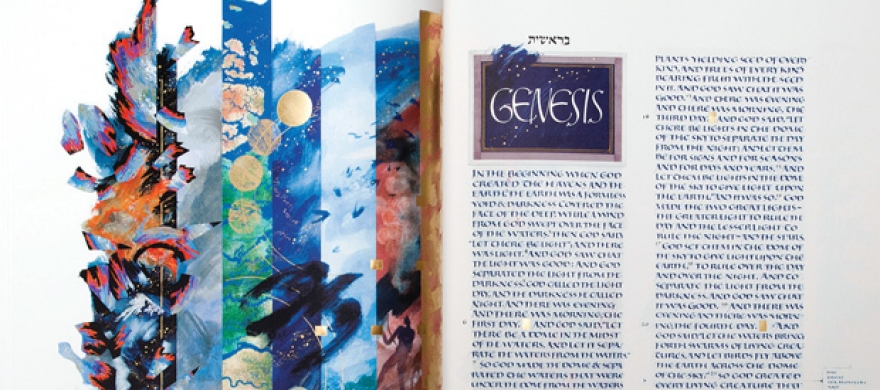As the first handwritten, illuminated Bible to be commissioned by a Benedictine Abbey in 500 years, the Saint John’s Bible is a throwback to a tradition that has largely disappeared in the West: art created primarily as religious worship. It was a tradition responsible for colorfully designed stained glass windows, Michelangelo’s celebrated paintings in the Sistine Chapel, and intricately illuminated manuscripts of scripture.
“The term ‘illuminated’ refers not only to the luminous effects of gold, silver, and other vibrant colors and materials used to illustrate and decorate these manuscripts, but also to the divine light of the Word of God,” explains associate professor of art history Cynthia Colburn. “For many Christians, the light of God’s Word became a physical reality in these works.”
 Handwritten, illuminated Bibles were mostly discontinued from this tradition after
the invention of the printing press in the mid-1400s, due to the length and cost of
creating such works. So as soon as Mark Roosa, dean of Pepperdine Libraries, learned
that the restorative Saint John’s Bible project included 360 handwritten “Heritage
Edition” copies of the new, original manuscript, he immediately set about trying to
secure one for Pepperdine’s collection.
Handwritten, illuminated Bibles were mostly discontinued from this tradition after
the invention of the printing press in the mid-1400s, due to the length and cost of
creating such works. So as soon as Mark Roosa, dean of Pepperdine Libraries, learned
that the restorative Saint John’s Bible project included 360 handwritten “Heritage
Edition” copies of the new, original manuscript, he immediately set about trying to
secure one for Pepperdine’s collection.
“We see Bibles from time to time and we see art books from time to time, but we don’t often see them joined as one as this book is,” Roosa notes. “It continues a time-honored practice of careful, painstaking writing down of the word of God in a way that is attractive to contemporary audiences. It’s seldom that we have an opportunity to acquire a work as precious as this one.”
The Heritage Edition is divided into seven volumes containing 160 intricate, unique illuminations of everything from Old Testament stories to the life of Christ—with a twist. “It’s quite unique in the sense that the illuminations are artistic in interpretation of scripture. Even in the earliest of the illuminated Bibles, the illuminations were quite literal,” Roosa explains, adding that the interpretive style, providing a modern touch, is just one of the features that audiences will appreciate.
“Those who are familiar with the Gospels and the Bible will be drawn to the Saint John’s Bible because it’s another way of understanding the Word. But I think it will also be attractive to the novice, who may not be familiar with manuscripts or Biblical texts; they’ll be drawn to it, I think, as an artistic work.”

The majority of the design was created by Donald Jackson, who conceived the project in the early 1970s and earned the commission in 1998 to begin work on the Bible from the Benedictine Monastery of Saint John’s in Collegeville, Minnesota. Jackson is the official scribe and calligrapher to Queen Elizabeth II, and is the author of The Story of Writing andThe Calligrapher’s Art.
“The art of calligraphy is terribly detailed and hard to do well, so this will be held up as an iconic work in the world of calligraphy,” Roosa predicts.
However, he stresses that Pepperdine didn’t acquire the Saint John’s Bible for admiration as a static exhibit in Payson Library but as a living, working piece of history for the community of Los Angeles. He has begun reaching out to congregations, of different faiths and traditions, to make it known that volumes will be available for worship, study, and enjoyment.
“There are different worship traditions and faiths that involve looking at illuminations and having prayerful meditation through them, which can be a jumping off point for going deeper into one’s faith. Conversely, we can also see it being used for more straightforward worship in which the text is read,” says Roosa. “We want to bring the book alive in our community and celebrate it as much as we can.”
The Saint John’s Bible Heritage Edition went on public display in Payson Library during the launch of Pepperdine’s 75th anniversary celebrations this fall. Learn how you can explore this exhibit: library.pepperdine.edu
